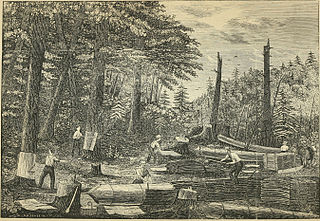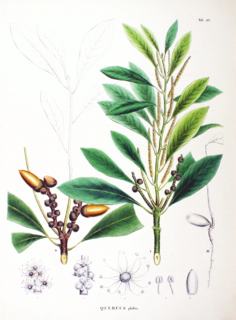
Fagaceae is a family of flowering plants that includes beeches and oaks, and comprises eight genera with about 927 species. Fagaceae in temperate regions are mostly deciduous, whereas in the tropics, many species occur as evergreen trees and shrubs. They are characterized by alternate simple leaves with pinnate venation, unisexual flowers in the form of catkins, and fruit in the form of cup-like (cupule) nuts. Their leaves are often lobed and both petioles and stipules are generally present. Their fruits lack endosperm and lie in a scaly or spiny husk that may or may not enclose the entire nut, which may consist of one to seven seeds. In the oaks, genus Quercus, the fruit is a non-valved nut called an acorn. The husk of the acorn in most oaks only forms a cup in which the nut sits. Other members of the family have fully enclosed nuts. Fagaceae is one of the most ecologically important woody plant families in the Northern Hemisphere, as oaks form the backbone of temperate forest in North America, Europe, and Asia and one of the most significant sources of wildlife fodder.

A nut is a fruit composed of an inedible hard shell and a seed, which is generally edible. In general usage and in a culinary sense, a wide variety of dried seeds are called nuts, but in a botanical context "nut" implies that the shell does not open to release the seed (indehiscent). The translation of "nut" in certain languages frequently requires paraphrases, as the word is ambiguous.

Lithocarpus is a genus in the beech family, Fagaceae. Trees in this genus are commonly known as the stone oaks and differ from Quercus primarily because they produce insect-pollinated flowers on erect spikes and the female flowers have short styles with punctate stigmas. At current, around 340 species have been described, all restricted to Southeast Asia. Fossils show that Lithocarpus formerly had a wider distribution, being found in North America and Europe during the Eocene to Miocene epochs. These trees do not tolerate freezing temperatures, because all species are evergreen and none are found in temperate zones, despite the lack of any geographic barrier to dispersal in the subtropical zone of East Asia. They extend from the foothills of the Hengduan mountains, where they form dominant stands of trees, through Indochina and the Malayan Archipelago, crossing Wallace's Line and reaching Papua. In general, these trees are most dominant in the uplands and have many ecological similarities to the Dipterocarpaceae, the dominant lowland tree group. These trees are also intolerant of seasonal droughts, not being found on the Lesser Sunda islands, despite their ability to cross numerous water barriers to reach Papua.
An oak is a tree or shrub in the genus Quercus in the plant family Fagaceae.

The Ton Pariwat Wildlife Sanctuary is located in the north of Mueang Phang Nga district, Phang Nga Province, southern Thailand. It covers an area of 224 square kilometres of forested hills at the southern end of the Phuket mountain range. It is part of a system of protected areas known as the southern forest complex, continued to the northwest by the Khlong Phanom National Park.
Lithocarpus hendersonianus is a tree species in the beech family Fagaceae. Trees in the genus Lithocarpus are commonly known as stone oaks and differ from Quercus primarily because they produce insect-pollinated flowers. This tree species is endemic to Peninsular Malaysia. It is categorized as Vulnerable by the IUCN Red List of Threatened Species, primarily due to habitat loss.

Tanbark is the bark of certain species of trees. It is traditionally used for tanning hides into leather.

Lithocarpus cleistocarpus is a species of stone-oak native to China. The flowers are white, and the nuts are flat, contained in a capsule. The tree is grown as an ornamental plant.

Lithocarpus edulis, the Japanese stone oak, is a species of stone-oak native to Japan. It is an evergreen tree growing up to 15 metres tall. The nuts are edible for people but taste bitter. The nuts contain tannins, however soaking them in water removes them. It is cultivated as an ornamental plant.

Acorn noodle soup, called dotoriguksu in Korean, is a noodle soup consisting of Korean noodles made from acorn flour or starch, salt, and a combination of grain-based flour.
Aimée Antoinette Camus was a French botanist. She was best known for her study of orchids and oaks. Camus also has the legacy of authoring the second highest number of land plant species among female scientists, in total naming 677 species.

Imazapyr is a non-selective herbicide used for the control of a broad range of weeds including terrestrial annual and perennial grasses and broadleaved herbs, woody species, and riparian and emergent aquatic species. It is used to eliminate Lithocarpus densiflorus and Arbutus menziesii. Additionally, imazapyr is used to control annual and perennial grass and broadleaved weeds, brush, vines and many deciduous trees. Imazapyr is absorbed by the leaves and roots, and moves rapidly through the plant. It accumulates in the meristem region of the plant. In plants, imazapyr disrupts protein synthesis and interferes with cell growth and DNA synthesis.

Lithocarpus glaber, the Japanese oak, is a tree species in the genus Lithocarpus found in Japan, China and Taiwan.

Notholithocarpus densiflorus, commonly known as the tanoak or tanbark-oak, is a broadleaf tree in the family Fagaceae, native to the western United States, in California as far south as the Transverse Ranges, north to southwest Oregon, and east in the Sierra Nevada. It can reach 40 m (130 ft) tall in the California Coast Ranges, and can have a trunk diameter of 60–190 cm (24–75 in).
Rectiostoma fernaldella is a species of moth in the family Depressariidae. It was described by Riley in 1889. It is found in North America, from southern Mexico to the eastern basin and range area in southern Arizona and disjunctly to California. There is also a record for Tennessee.
Lithocarpus encleisacarpus is a tree in the beech family Fagaceae. The specific epithet is from the Greek meaning "enclosed fruit", referring to the acorns and cupules. The cupule is not fused to the nut though and often becomes irregularly dehiscent. The degree to which the nut is enclosed by the cupule varies across its geographic range. Trees in Lithocarpus are commonly known as the stone oaks and differ from Quercus primarily because they produce insect-pollinated flowers.
Lithocarpus gracilis is a tree in the beech family Fagaceae. The specific epithet gracilis is from the Latin meaning "slender", referring to the twigs.
Lithocarpus jacobsii is a tree in the beech family Fagaceae. It is named for the Dutch botanist Marius Jacobs. Trees in Lithocarpus are commonly known as the stone oaks and differ from Quercus primarily because they produce insect-pollinated flowers.
Lithocarpus revolutus is a tree in the beech family Fagaceae. The name is derived from the way in which the margins of the leaves are typically rolled in upon themselves (revolute). Trees in Lithocarpus are commonly known as the stone oaks and differ from Quercus primarily because they produce insect-pollinated flowers.

The Sumatran montane rain forests ecoregion covers the mountainous elevations of the Barisan Mountains Range that runs the length of the southwestern side of the island of Sumatra in Indonesia. The ecoregion is almost completely surrounded by the lower elevation Sumatran lowland rain forests. The area is one of very high biodiversity - because of the relative isolation, and variety of forest types, there are 7 endemic species of mammals and eight endemic species of birds.











